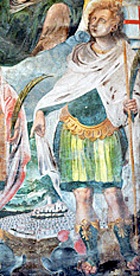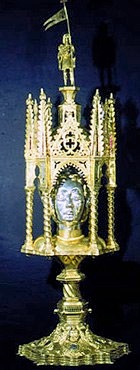


St Secundus: detail from the the altarpiece (16th century) of San Secondo, Amelia
attributed to Livio Agresti
An entry in the Roman Martyrology under 1st June reads:
-
“At Amelia in Umbria, in the reign of Diocletian, St Secundus, martyr, who fulfilled his martyrdom when thrown into the Tiber”.
As Edoardo d’Angelo (referenced below, at p. 57) observed:
“The Latin documentation of the legend [of St Secundus exists in two versions] depending on the place of burial:
-
✴the version BHL 7558 and 7558a places it at Gubbio (feast 10th May); while
-
✴a second version (BHL 7559, 7559a, 7559b, 7560, 7560b) places it at Amelia (feast 1st June)”( my translation).
Edoardo d’Angelo (as above) has demonstrated (at p. 68) has demonstrated that all the other versions listed here derive from BHL 7559, which he reproduced as Appendix II. He noted (at note 3) that, while the feats is usually celebrated on 1st June, the edition that he reproduced gave the dies natalis as 1st January: he suggested (at p. 69) that this version wa probably written at the Abbazia di farfa in ca. 800.
San Secondo at Amelia
According to his legend (BHL 7558-60), he was a Roman soldier and devout Christian. During the persecutions of 303 AD, he was arrested at Amelia and taken for trial in Spoleto. There, at his request, God destroyed the temple of Hercules. St Secundus was sent back to Amelia and thrown into the Tiber there with a stone around his neck. His body was miraculously recovered and a pious lady called Eudoxia arranged for its burial on land that she owned just outside the city (traditionally, on the site of the future Abbazia di San Secondo).
St Secundus was revered as the protector of the dead. In the 16th century, the church of the Abbazia di San Secondo at Amelia became the home of the Confraternita della Buona Morte, which was dedicated to the burial of the poor.
San Secondo at Gubbio

n 1285, the presumed head of St Secundus and the bodies of St Agapitus and one of the female martyrs among his companions (traditionally St Justina) were handed over to the Augustinians of the nearby town of Pergola that the Gubbians had founded. The reliquary (15th century) of St Secundus is preserved in the Duomo there.
Read more:
E. d’ Angelo, “Il Dossier ‘Amerino di San Secondo”, Bollettino della Deputazione di Storia Patria per l' Umbria, 107 (2010) 57-86
Return to Saints of Amelia or Saints of Gubbio.

